[Testing] Kingston DataTraveler 2000 Secure USB Drive with PIN Pad
Hello Giktayms! The flash drive, which caused a lot of comments from the hawkers, came to me for a test. We are talking about the acclaimed DataTraveler 2000 , the drive, which is not 100% a product of Kingston, but at the same time, very interested in users. I will say right away that I will not crack the installed PIN code with improvised means, for all other details, I ask for a cat.

At the time of publication of the article, the price in Russian retail is still unknown: market.yandex.ru/product/13459150 - I think that a 16 gigabyte drive will cost potential buyers about 6,000 rubles (about 80 euros at the current exchange rate).
The key difference from all other drives is the presence of a physical PIN pad. This method of protection is the most reliable. The development of iStorage is a niche product and collaboration with Kingston will expand the horizons for promoting secure drives to the masses.
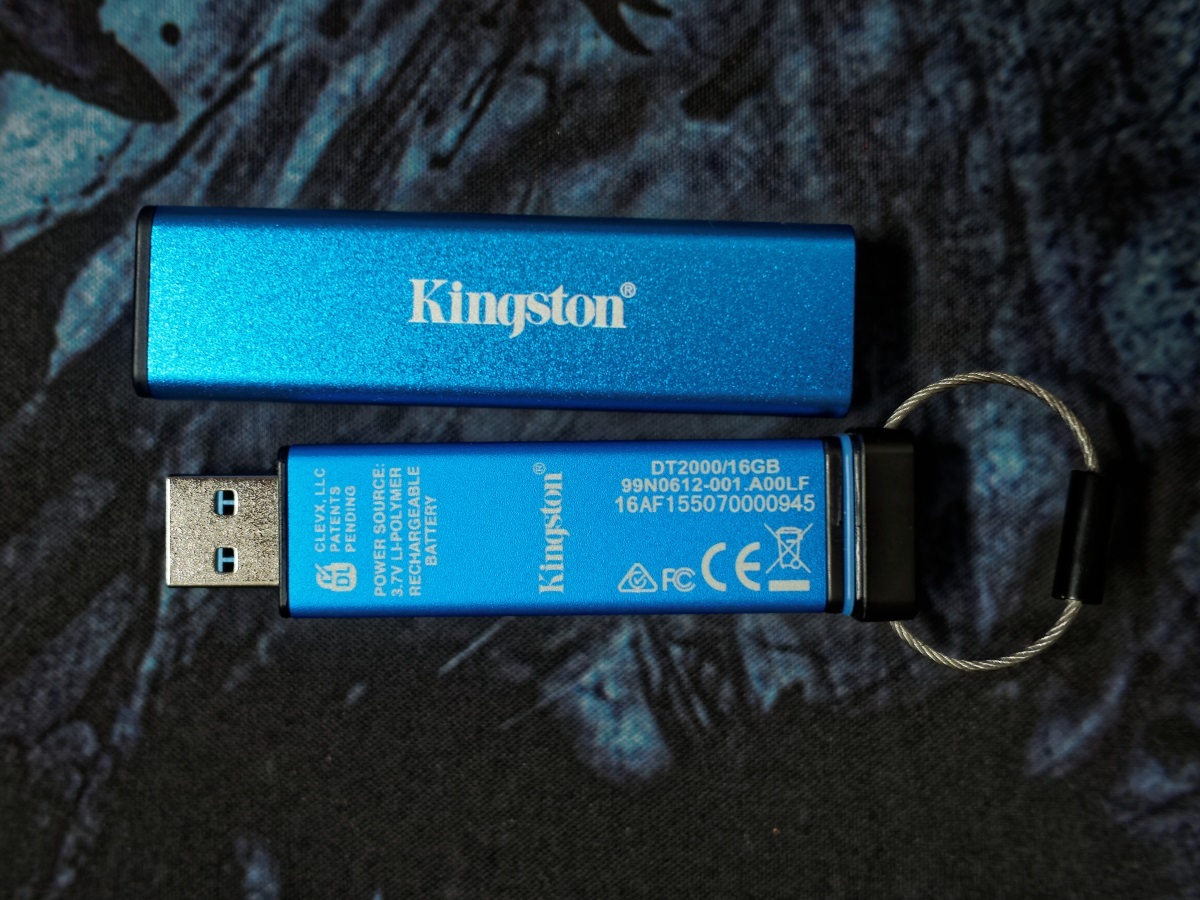
The iStorage developer logo flaunts at the end of the flash drive, information on collaboration with ClevX is printed on the side faces. The cooperation of the three companies has brought quite good results.
Inside the DataTraveler 2000, a small Li-Pol battery with a voltage of 3.7V is installed to maintain the health of the encryption system. Recharging is automatic when connected via USB. The period of autonomous lying on the shelf is about one year, after the battery dies, the PIN pad data will be reset. A huge number of questions are explained in the Russian-language manual .
It is not possible to physically disassemble a flash drive without damaging the board and preserving at least some decent appearance, so there will be a little tin.

Initially, the flash drive is disassembled by unscrewing the two screws on the end under the sticker and then the board can be pulled out of the aluminum tube. But the screws are lacquered and one of them did not want to leave their homes. I had to pick up a dremel. By the way, owning it on level 80 is not among my virtues, but I mastered cutting the case in half without problems and in five minutes.
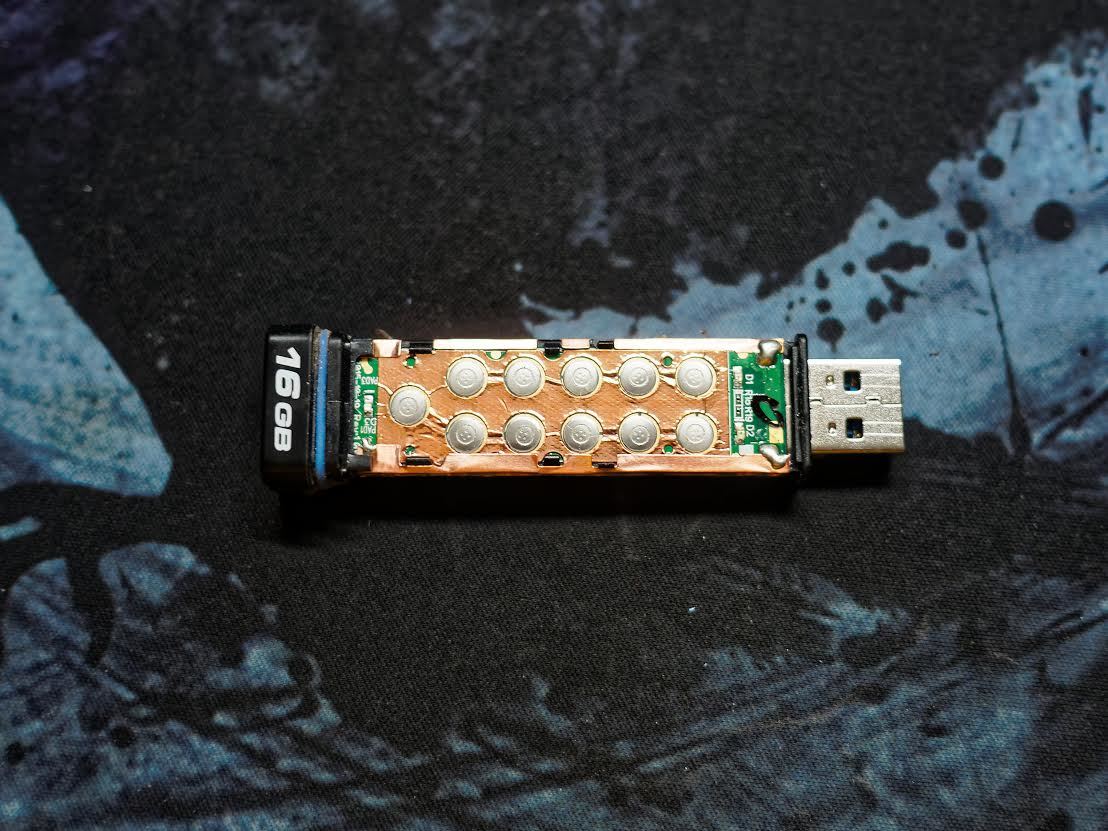
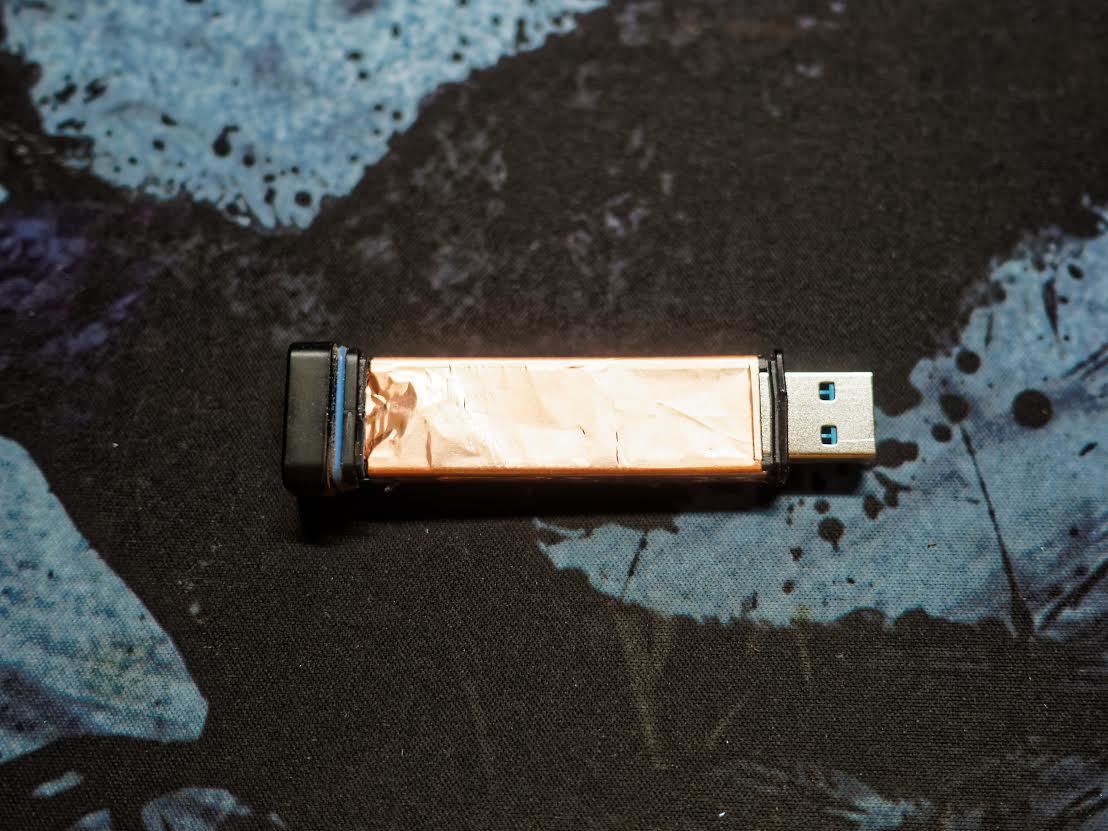
Inside a circuit board wrapped in copper foil. Gently remove the foil, what's under it? On the one hand, the PIN pad is expectedly located, on the other - the battery and that's all ... One of the sides of the board is filled with black plastic and finding out what is very difficult inside.
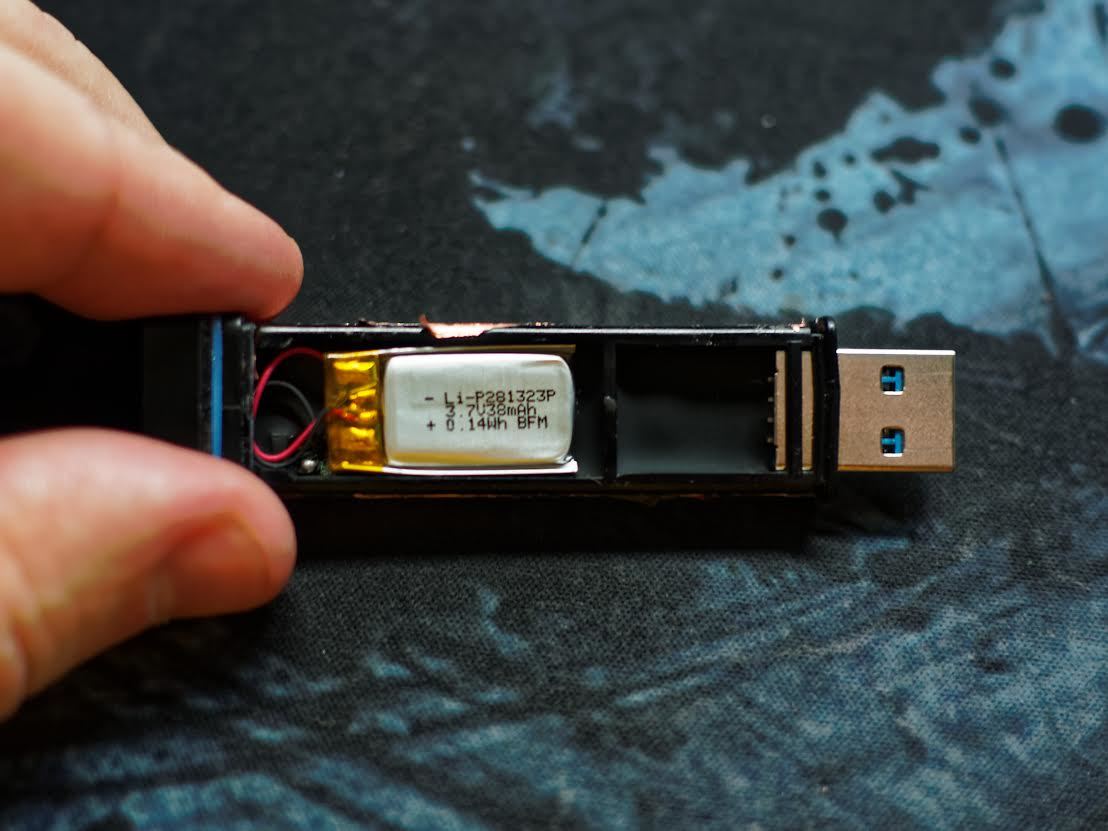
Plastic turned out to be unmatched in quality, and heating with a hairdryer allowed only small pieces to be peeled off, and even then with damage to the printed circuit board. This composition did not take the solvent; all that remained was to patiently and slowly heat and chip the fragments.
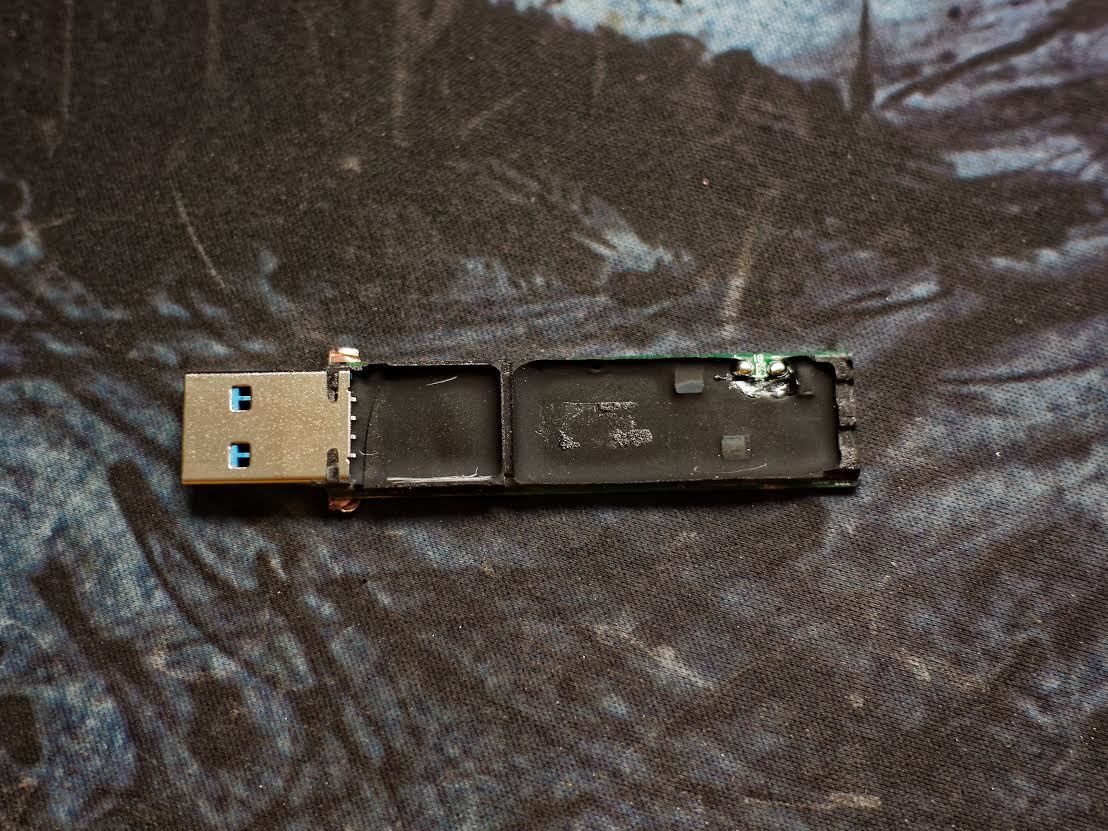
At some point, apparently I overheated the textolite, a crack went and a breakaway large piece of plastic took half of the memory chip with me and exposed the contacts of the landing pad.
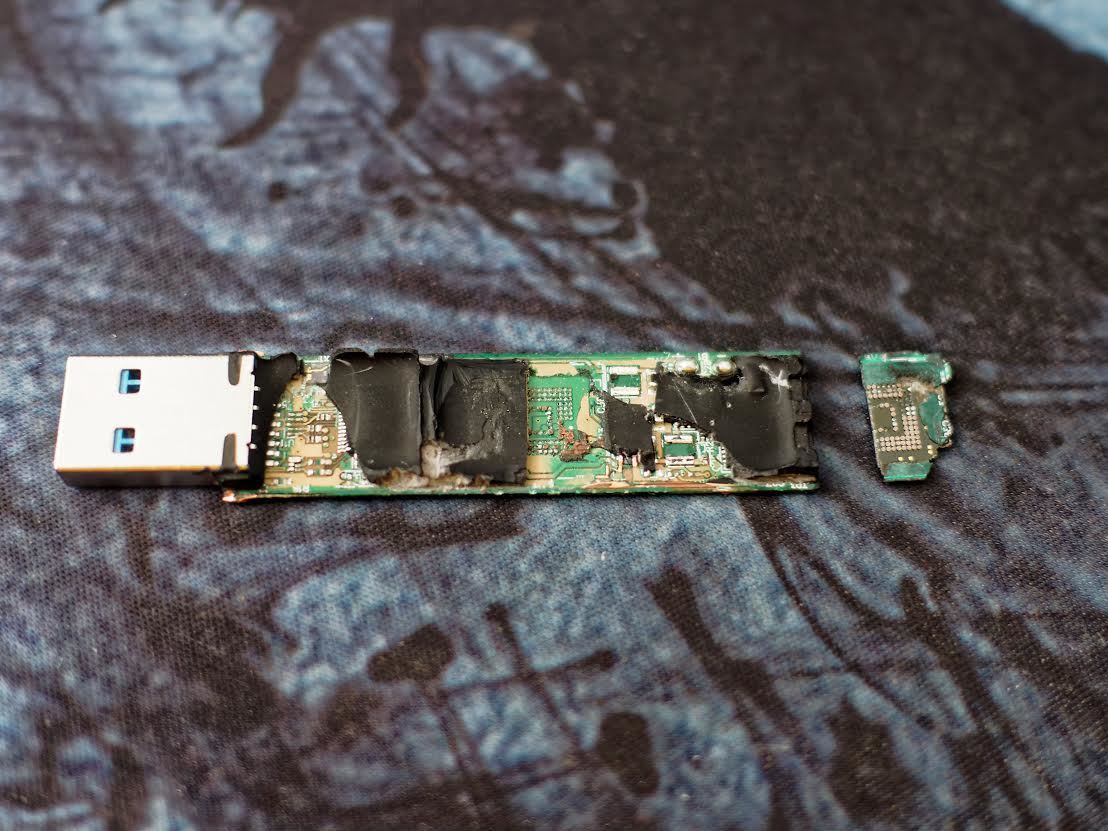
The USB flash drive is protected from flags and dust according to the IP57 standard - that is, dust that does not affect the operation of the device can get inside and during short-term immersion to a depth of 1 meter the drive will remain operational.
According to the Flash Drive Information Extractor program, the Phison PS2313 controller is used(it was not possible to verify this fact live), information on memory chips is not available programmatically.
The physical disk size is 15 502 147 584 bytes, by default the flash drive is formatted in FAT32, but, at the request of the user, it can work in exFAT or NTFS.
To unlock the flash drive, you need to press the key with the image of the key, then enter the default PIN 11223344, then again the key with the key. A green LED on the USB flash drive will signal that the device has been unlocked. After that, within 30 seconds you need to connect the USB flash drive to the computer. If this is not done, the drive will lock again. When working with a flash drive, no additional programs are required. When you remove the device from the USB connector, the lock occurs automatically.
The user manual describes in detail the process of changing the default PIN, and immediately after the acquisition, you should carry out this procedure. PIN codes from 7 to 16 characters are supported.
A little about protection - after 10 incorrect attempts to enter the PIN code, the contents of the flash drive are deleted, and then you can carry out the password reset procedure and use the drive further, but recovery of the deleted files will fail.
The actual disk capacity is 15 502 147 584 bytes, which, when converted, gives about 14 gigabytes. As I already wrote, the drive uses Toshiba type MLC memory and the Phison PS2251 controller.
A synthetic test to assess the correctness of the manufacturer's stated speeds. Actually, most of the data indicated on the boxes of flash drives and SSDs of different manufacturers was obtained using ATTO Disk Benchmark.
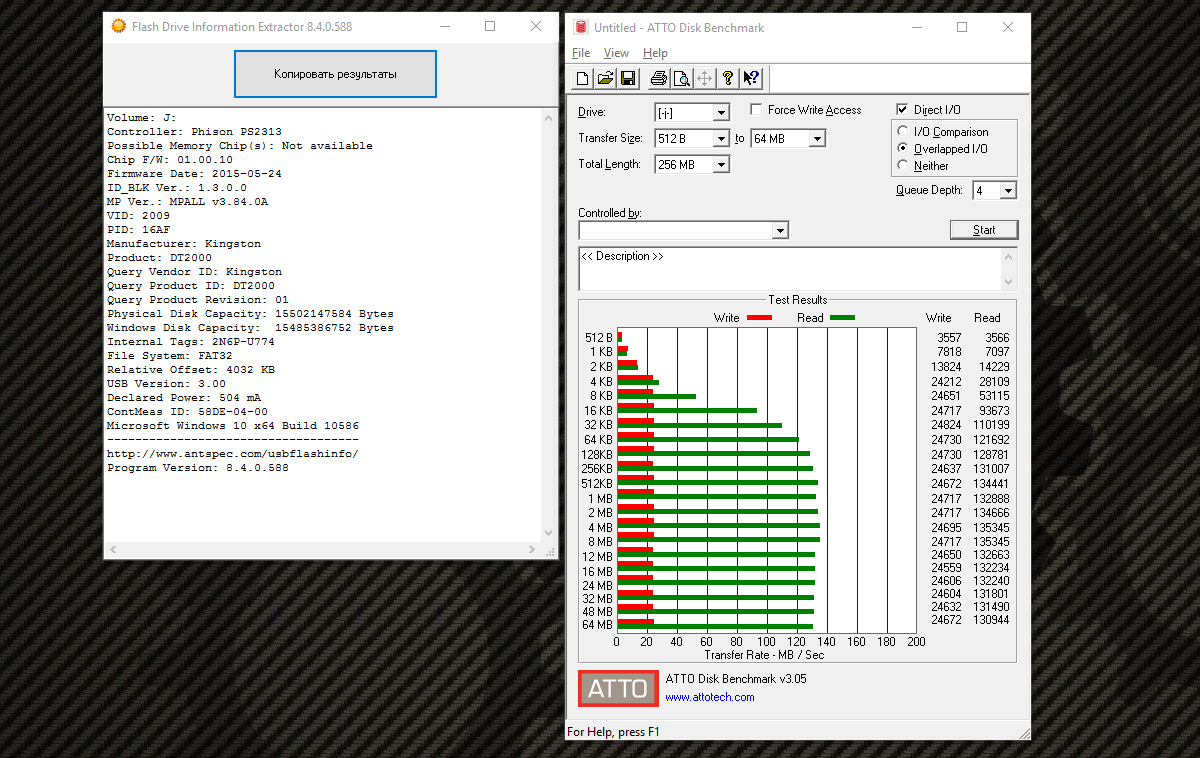
This test allows you to evaluate the operation of the drive in four modes: linear read / write, read / write blocks in 4K, linear read / write with a depth of 32 teams, read / write blocks in 4K with a depth of 32 teams.
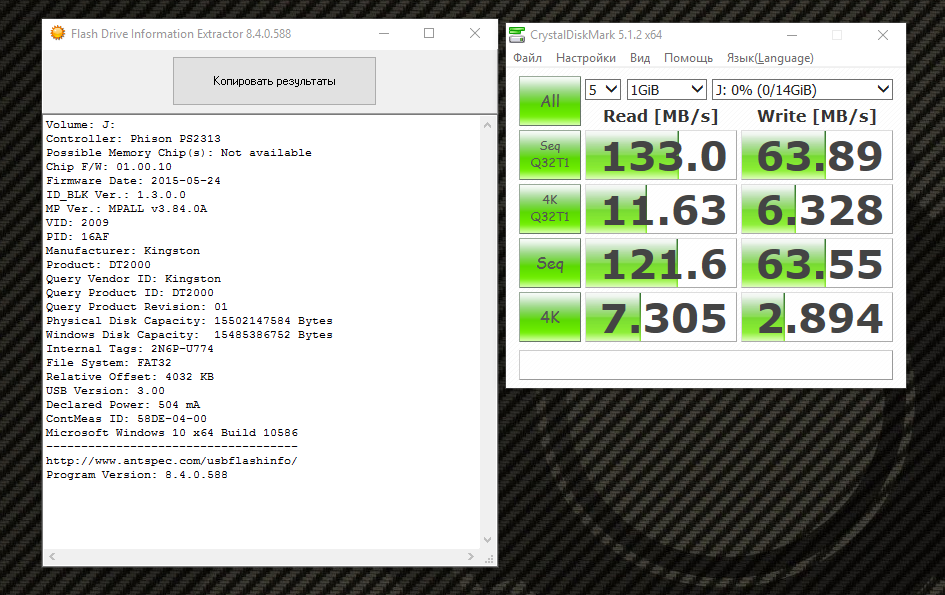
This application has an additional test that uses three scenarios of working with files: ISO (two large files), Program (folder with a large number of small files) and Games (folder with an assortment of large and small files)
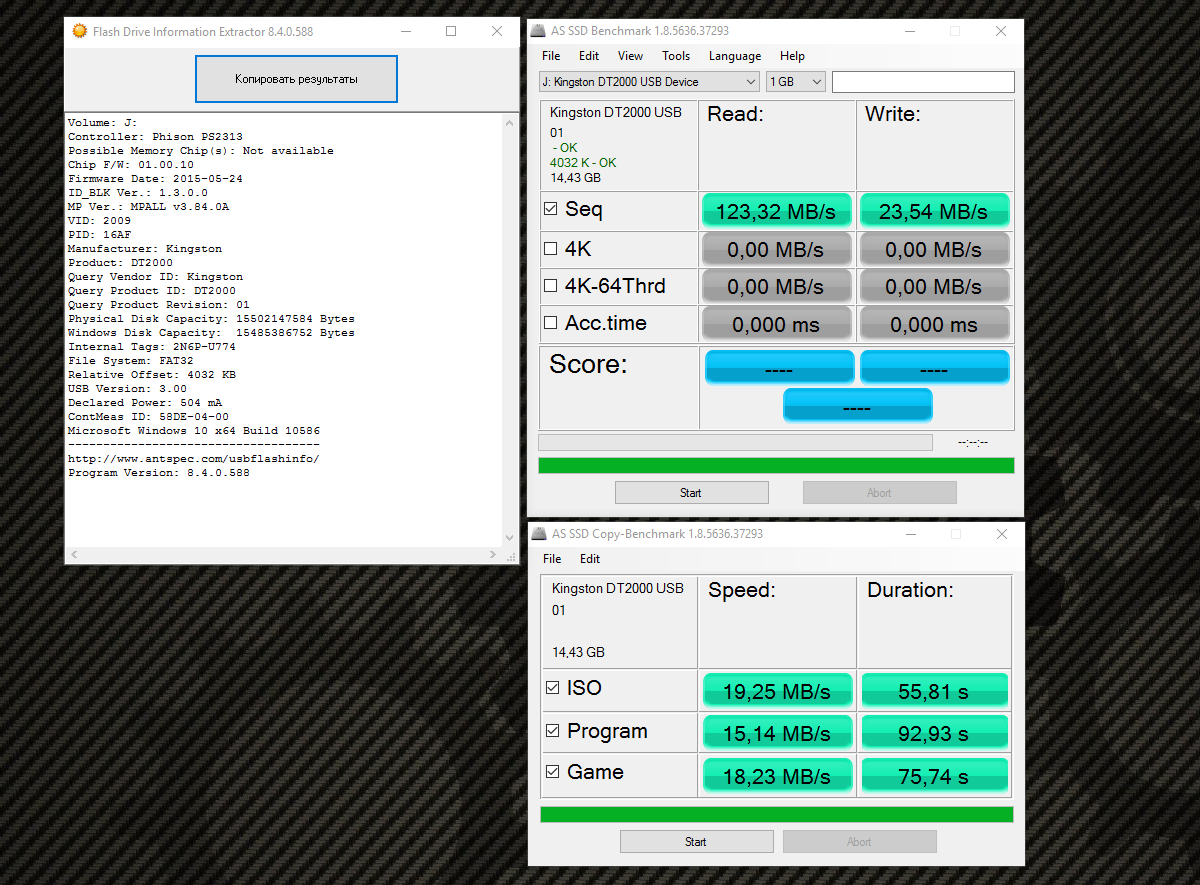
Kingston DataTraveler 2000 is not the fastest and not the smallest flash drive. This is a purely niche product for knowledgeable people. If earlier it was not easy to find iStorage products in Russia, then thanks to cooperation with Kingston everyone (it’s clear that who really needed it, they already bought it) will have the opportunity to use such protected devices.
At the same time, I note that a good speed and protection from external influences are a prerequisite for demanding customers.
Thanks for watching and stay with Kingston on the Guktime!
For more information on Kingston and HyperX products, visit the company's official website . Page with visual aid will help you choose your HyperX kit.

At the time of publication of the article, the price in Russian retail is still unknown: market.yandex.ru/product/13459150 - I think that a 16 gigabyte drive will cost potential buyers about 6,000 rubles (about 80 euros at the current exchange rate).
The key difference from all other drives is the presence of a physical PIN pad. This method of protection is the most reliable. The development of iStorage is a niche product and collaboration with Kingston will expand the horizons for promoting secure drives to the masses.

The iStorage developer logo flaunts at the end of the flash drive, information on collaboration with ClevX is printed on the side faces. The cooperation of the three companies has brought quite good results.
Inside the DataTraveler 2000, a small Li-Pol battery with a voltage of 3.7V is installed to maintain the health of the encryption system. Recharging is automatic when connected via USB. The period of autonomous lying on the shelf is about one year, after the battery dies, the PIN pad data will be reset. A huge number of questions are explained in the Russian-language manual .
It is not possible to physically disassemble a flash drive without damaging the board and preserving at least some decent appearance, so there will be a little tin.

Initially, the flash drive is disassembled by unscrewing the two screws on the end under the sticker and then the board can be pulled out of the aluminum tube. But the screws are lacquered and one of them did not want to leave their homes. I had to pick up a dremel. By the way, owning it on level 80 is not among my virtues, but I mastered cutting the case in half without problems and in five minutes.


Inside a circuit board wrapped in copper foil. Gently remove the foil, what's under it? On the one hand, the PIN pad is expectedly located, on the other - the battery and that's all ... One of the sides of the board is filled with black plastic and finding out what is very difficult inside.

Plastic turned out to be unmatched in quality, and heating with a hairdryer allowed only small pieces to be peeled off, and even then with damage to the printed circuit board. This composition did not take the solvent; all that remained was to patiently and slowly heat and chip the fragments.

At some point, apparently I overheated the textolite, a crack went and a breakaway large piece of plastic took half of the memory chip with me and exposed the contacts of the landing pad.

The USB flash drive is protected from flags and dust according to the IP57 standard - that is, dust that does not affect the operation of the device can get inside and during short-term immersion to a depth of 1 meter the drive will remain operational.
According to the Flash Drive Information Extractor program, the Phison PS2313 controller is used(it was not possible to verify this fact live), information on memory chips is not available programmatically.
The physical disk size is 15 502 147 584 bytes, by default the flash drive is formatted in FAT32, but, at the request of the user, it can work in exFAT or NTFS.
To unlock the flash drive, you need to press the key with the image of the key, then enter the default PIN 11223344, then again the key with the key. A green LED on the USB flash drive will signal that the device has been unlocked. After that, within 30 seconds you need to connect the USB flash drive to the computer. If this is not done, the drive will lock again. When working with a flash drive, no additional programs are required. When you remove the device from the USB connector, the lock occurs automatically.
The user manual describes in detail the process of changing the default PIN, and immediately after the acquisition, you should carry out this procedure. PIN codes from 7 to 16 characters are supported.
A little about protection - after 10 incorrect attempts to enter the PIN code, the contents of the flash drive are deleted, and then you can carry out the password reset procedure and use the drive further, but recovery of the deleted files will fail.
Kingston DataTraveler 2000 Speed Specs
Test stand
- Processor: Intel Core i7-5960X
- Motherboard: Gigabyte X99-SOC Champion, Intel Socket 2011-3
- RAM: HyperX Predator DDR4-3000 16 Gb (4 * 4 Gb)
- System SSD: HyperX Predator PCI-E SSD 480 Gb
- Video Card: AMD Fury X
- Power Supply: Corsair AX1200i, 1200W
- Operating System: Windows 10 Professional (64-bit)
The actual disk capacity is 15 502 147 584 bytes, which, when converted, gives about 14 gigabytes. As I already wrote, the drive uses Toshiba type MLC memory and the Phison PS2251 controller.
Specifications
- USB 3.1 Gen 1 (USB 3.0)
- Capacity 16GB, 32GB
- USB 3.1 speed: 16GB: 120MB / s (read), 20MB / s (write); 32GB: 135MB / s (read), 40MB / s (write)
- USB 2.0 speed: 16GB: 30MB / s (read), 20MB / s (write); 32GB: 30MB / s (read), 20MB / s (write)
A set of test applications:
- ATTO disk benchmark 3.0.5
- Crystal Disk Mark 5.1.2
- IOMeter 1.1.0
- PC Mark 8
ATTO disk benchmark 3.05
A synthetic test to assess the correctness of the manufacturer's stated speeds. Actually, most of the data indicated on the boxes of flash drives and SSDs of different manufacturers was obtained using ATTO Disk Benchmark.

Crystal Disk Mark 5.0.2
This test allows you to evaluate the operation of the drive in four modes: linear read / write, read / write blocks in 4K, linear read / write with a depth of 32 teams, read / write blocks in 4K with a depth of 32 teams.

AS SSD benchmark 1.8.5636
This application has an additional test that uses three scenarios of working with files: ISO (two large files), Program (folder with a large number of small files) and Games (folder with an assortment of large and small files)

Final thoughts
Kingston DataTraveler 2000 is not the fastest and not the smallest flash drive. This is a purely niche product for knowledgeable people. If earlier it was not easy to find iStorage products in Russia, then thanks to cooperation with Kingston everyone (it’s clear that who really needed it, they already bought it) will have the opportunity to use such protected devices.
At the same time, I note that a good speed and protection from external influences are a prerequisite for demanding customers.
Thanks for watching and stay with Kingston on the Guktime!
For more information on Kingston and HyperX products, visit the company's official website . Page with visual aid will help you choose your HyperX kit.
